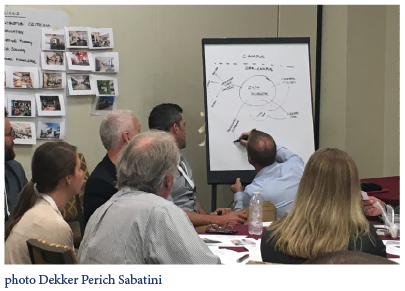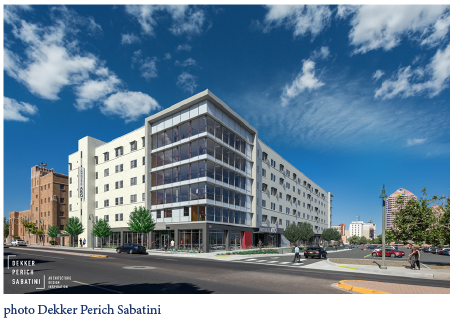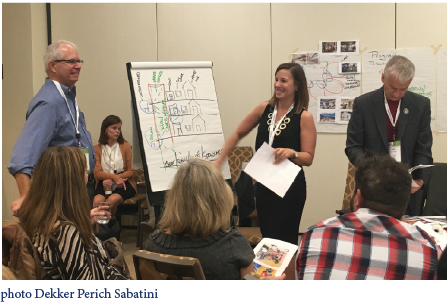The Future of Academic Incubators: New Models for Academic-Industry Collaboration
By Julie Walleisa, Megan Hutchraft and Kate Dimock
Over 100 designers and educators worked together at a facilitated workshop to create a vision for the future of academic incubators, to try to address the following questions:
How can planning and design help today’s academic incubators promote innovation
and collaboration between academia and industry?
– How can incubators help universities attract students and serve unmet needs?
– What type of physical environment is needed for the next generation of academic incubators?
Evolution of Incubators
The National Business Incubation Association defines incubation as “a business support process that accelerates the successful development of start-up and fledgling companies by providing entrepreneurs with an array of targeted resources and services… a business incubator’s main goal is to produce successful firms that will leave the program financially viable and freestanding.”
The goals of academic incubators, those directly tied to a university, have evolved. In addition to generating revenue from research produced on campus and contributing to local economic growth, incubators focus on fostering lifelong entrepreneurship and innovation by helping aspiring entrepreneurs translate their ideas into a business, invention or social movement and learn from both successes and failures. Incubator programs are also a valuable way to attract and retain students that don’t see the relevance of a degree, and might otherwise drop out of school to focus full time on building their companies. The success of an academic incubator is tied to both successful business launches and to developing lifelong skills.
While there are many variations, most incubators provide a combination of physical space for student entrepreneurs to work, meet and create; services such as administrative support, consulting and sometimes direct financial support; access to a network of other entrepreneurs, experts, suppliers and venture capitalists; and intangible qualities like strategic guidance and a forum for idea exchange and mentorship.

We can trace the roots of today’s incubators back to the 1950s; this decade saw the first university-owned research park started near Stanford with tenants like Hewlett-Packard and General Electric, the first multi-university partnership in North Carolina, and the first recognized business incubator, the Batavia Industrial Center in New York. Early incubators were mostly about providing affordable office space to startups. This simple focus continued into the 1970s, with many government-sponsored incubators started in response to economic drivers and the Small Business Administration promoting incubator development. Incubators then started to focus more on providing useful coaching and services in addition to workspace, which made universities a natural partner. In the last 15 years we’ve seen the birth of accelerators and formal co-working spaces, alongside steady growth of incubators. Today, academic institutions sponsor nearly one-third of North American business incubators. While the earliest incubators were typically mixed-use, more recent incubators have targeted specific industries or audiences. This evolution raises the question of how incubators can be optimized for the specific needs of varied fields and settings, while remaining adaptable for the future.
Diversity of Current Incubators
There exists a misperception that successful incubator design needs to look like the headquarters of a tech company. However, as University Business Incubator Index co-creator Dhruv Bhatli observed, “[Top incubators] are not trying to replicate something else like Silicon Valley. Each ecosystem is so specific in its own way and unique in so many ways.” While some incubators do have that tech company look and have been successful in serving entrepreneurial students, an incubator’s physical space must be designed in accordance with its organizational goals in order to be resilient and adaptable to the specific startups they are built to serve. Each incubator’s definitive needs and goals differentiate one from the next, and some of these differentiators include the incubator’s focus, location, space, and lastly, the specific combination of faculty, industry leaders, mentors, and business experts used to run the incubator. Following are several examples of academic incubators that show the diversity of programs and needs.
La Kretz Innovation Campus is a facility for Los Angeles’ Cleantech Incubator intended to help boost the economy of the city. With municipal and university partnerships supporting it, La Kretz is located in the heart of LA’s Downtown Arts and Innovation District as an effort to provide economic stimulus to the area. The facility serves entrepreneurs, engineers, scientists and policymakers in their efforts to develop clean technologies. It includes a mix of work and office space, a prototyping and training center and an amphitheater, all in an open, vibrant environment where the message behind the organization’s goals is celebrated throughout.

Similarly, Innovate ABQ is supported by a diverse partnership between the University of New Mexico, the City of Albuquerque, and private developers in an effort to rejuvenate Downtown Albuquerque through successful startup companies. Their first new building, located between Downtown Albuquerque and UNM’s campus, is currently under construction and was developed as a Live/Work/Play concept where students can experience a 24/7 immersive business and learning environment. The ground level is a “playground” with an incubator, co-work office space, fabrication and design visualization labs, and common areas for students and public ventures alike. The upper floors include two-bedroom student apartments and common space.
Unlike these off campus incubators supported by numerous partners, the Dean L. Hubbard Center for Innovation and Entrepreneurship is located on the Northwest Missouri State University campus and focuses on academic and mixed-use incubation endeavors. The building’s incubator wing supports several startups, mostly science and technology companies, with $3 million worth of scientific instruments and a combination of office space, lab analysis research areas and a shipping and receiving center. An Analytical Laboratory offers assistance from on-site staff and a full-time professional chemist and provides contract research and development assistance to small businesses, including those in the incubator.
Lassonde Studios of University of Utah is also in the heart of campus. Run by the Lassonde Entrepreneur Institute for the School of Business, Lassonde Studios opened in fall 2016 for 400 entrepreneurial students to Live/Create/Launch their businesses. The ground floor includes a 20,000 square foot hub of activity with innovation and business plan competitions, product prototyping, guest speakers, food and beverage service, and a place to connect with mentors and business leaders. The upper floors include common spaces for student residents and 1-4 bed traditional living units or single pods with a bed, dresser, and closet. Rounding out each floor are meeting areas for study and leisure.
These incubators demonstrate a diverse set of organizational and design needs depending on stakeholders, location, types of startups supported, and the level of student immersion in the entrepreneurial spirit. These incubators clearly indicate there is no one-size-fits-all approach to successful incubator design.
Relationship to Learning Theory
How does learning theory differ between a traditional setting and an academic incubator? Professor Vanessa Svihla of University of New Mexico’s Organizational, Information, and Learning Sciences once said, “Learning theories are like toothbrushes: Everyone has one, but no one wants to use anyone else’s.” There are hundreds of learning theories and many are interrelated, often used in conjunction with one another. For example, Behaviorism is a common theoretical approach that focuses on a learner’s reaction to external stimuli, while Social Learning Theory focuses on how others contribute to one’s own learning. What makes the conversation about the next generation of learning interesting is not about which theories incubators use, but instead how they use them differently.
Incubators are meant to inspire innovation: the novel ideas that can develop when people with dissimilar knowledge or dissimilar projects collide. Incubators have the ability to capitalize on these interactions. For example, an engineering student and a fashion student might find themselves collaborating on a project in an incubator, but in a traditional setting, their coursework would not overlap, and they would instead be working with their like-minded peers. Everett Rodgers introduced this concept in his progressive book Diffusion of Innovations which seeks to explain how, why and how quickly new ideas spread.
Another benefit incubators can provide is Just-In-Time (JIT) learning. This means just the right amount of information to accomplish the task at hand, not too soon or too late, too much or too little. It is just the right amount at the right time. JIT is a task-based approach, versus the traditional knowledge-based approach to learning, in which students learn relevant information when they need it to accomplish a task. This process, based on Ohno’s LEAN principles intended to minimize waste and create value with few resources, can lead to major efficiencies. In an incubator, a student might connect with a marketing expert to produce a quick-turnaround marketing plan rather than take a semester-long marketing course.
Learning from adjacencies is a third academic advantage of incubators. Adjacencies allow learners to observe others’ work and then “borrow” relevant practices to enhance their own work. This concept builds on Social Constructivism which explains how learners construct their own meaning and relevance of information through social interactions
Ultimately, the various perspectives and opportunities incubators provide support Cognitive Flexibility Theory, or the ability to spontaneously restructure one’s knowledge and adapt to rapidly changing situations. This mental adaptability contributes to lifelong learning and prepares students to continue innovating even after leaving the academic incubator.
Directions for Continued Evolution
Applying this background knowledge, workshop participants brainstormed design solutions for different startup companies and different types of incubators. Common themes emerged, including consensus that incubators should endow students with qualities of resilience, perseverance and adaptability; develop skills such as problem-solving, cross-cultural collaboration, networking, project management and communication; and support specific skills required to help each proposed business succeed.

Incubator design can physically reinforce these qualities. Labs designed to promote iterative experimentation and prototyping and display the full range of results, including failures, can emphasize the need to celebrate process and mistakes along with success. Depending on focus, incubators may need a variety of workspaces, wet, dry, and damp labs, messy maker spaces, and comfortable collaboration pods. These thoughtfully designed spaces should also be integrated with mobile or unfinished spaces that students can easily modify so the space is as adaptable and resilient as the students.
Participants considered practical issues, like access to unusual resources for hands-on experimenters and how to balance the desire for transparency and knowledge sharing against the need for patent security. Incubators don’t exist in a vacuum. Incubator design should help student entrepreneurs connect to outside organizations, mentors and neighbors in spaces for public showcases, informal pitches, tasting windows and testing stations to generate buzz and feedback. This approach can support the ideals of lean, minimalist startups by encouraging partnerships rather than duplicating spaces and equipment.
As incubators continue to evolve, it is important to consider how their specific components can empower both business launches and lifelong learning and support a range of students – introverts and extroverts, seasoned and overwhelmed. The demand from employers for specific entrepreneurial skills, such as collaboration and teamwork, communication and critical thinking is making project-based learning and the opportunities academic incubators provide more valuable at the collegiate level. If this is what students are doing in college, what is needed in high school to prepare them for this type of project-based learning with very real risks and rewards?
References
1. National Business Incubation Association (NBIA; 2015). What is Business Incubation? Retrieved August 2016, from http://www2.nbia.org/resource_library/what_is/index.php
2. National Business Incubation Association (2012). 2012 State of the Business Incubation Industry.
3. Schmitt, J. (2014). The Top University Business Incubators. Poets and Quants website. Retrieved August 2016, from http://poetsandquants.com/2014/09/22/the-top-university-business-incubators
4. LACI (2015). La Kretz Innovation Campus. Retrieved August 2016, from www.laincubator.org
5. Innovate ABQ (2016). Lobo Rainforest @ Innovate ABQ. Retrieved August 2016, www.innovateabq.com
6. Northwest Missouri State University (2013). Dean L. Hubbard Center for Innovation and Entrepreneurship. Retrieved August 2016, from http://nwmissouri.edu/cie/
7. The University of Utah Lassonde Entrepreneur Institute (2016). Lassonde Studios. Retrieved August 2016, from www.lassonde.utah.edu/studios
8. Rogers, E.M. (2003). Diffusion of Innovations, Fifth Edition. Free Press, pp 1-576.
9. Clark, D.R. (2010). Instructional Design – Just-In-Time Learning. Retrieved August 2016, from http://www.nwlink.com/~donclark/hrd/media/jit.html
10. Ohno, T. (1988). Toyota Production System: Beyond Large-Scale Production. CRC Press, pp 1-176.
FOOTNOTES
1NBIA website
22012 State of the Business Incubation Industry, report by NBIA
3Schmitt, J., 2014.
⁴LACI, 2015.
⁵Innovate ABQ, 2016.
⁶Northwest Missouri State University, 2013.
⁷The University of Utah Lassonde Entrepreneur Institute, 2016.
⁸Rogers, E.M., 2003.
⁹Clark, D.R., 2010.
10Ohno, T., 1988.
———————————
About Julie Walleisa
Julie Walleisa, AIA, LEED AP, ALEP is an Accredited Learning Environment Planner (ALEP) with Dekker/Perich/Sabatini who specializes in K-12 and higher education design.
About Megan Hutchraft
Megan Hutchraft, RA, also with Dekker/Perich/Sabatini, is an architect with experience in innovative commercial and educational environments.
About Kate Dimock
A licensed interior Perich/Sabatini designer with expertise in organizational learning, change management and human behavior.
